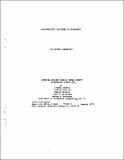| dc.contributor.author | Snyder, Troxell Kimmel | |
| dc.contributor.author | Bentley, Jeffrey | |
| dc.contributor.author | Giebler, Martin | |
| dc.contributor.author | Glicksman, Leon R. | |
| dc.contributor.author | Rohsenow, Warren M. | |
| dc.date.accessioned | 2006-03-06T16:47:35Z | |
| dc.date.available | 2006-03-06T16:47:35Z | |
| dc.date.issued | 1977-01 | |
| dc.identifier.other | 06994028 | |
| dc.identifier.uri | http://hdl.handle.net/1721.1/31240 | |
| dc.description | Thesis. 1977. M.S.--Massachusetts Institute of Technology. Dept. of Mechanical Engineering. | en |
| dc.description.abstract | The purpose of this years' work has been to test and analyze the new dry cooling tower surface previously developed. The model heat transfer test apparatus built last year has been instrumented for temperature, humidity and flow measurement and performance has been measured under a variety of operating conditions.
Tower Tests showed approximately 40-50% of the total energy transfer as taking place due to evaporation. This can be compared to approximately 80 to 85% for a conventional wet cooling tower. Comparison of the model
tower test results with those of a computer simulation has demonstrated the validity of that simulation and its use as a design tool. Computer predictions have been made for a full-size tower system operating at
several locations.
Experience with this counterflow model tower has suggested that several design problems may be avoided by blowing the cooling air horizontally through the packing section. This crossflow concept was built from the previous counterflow apparatus and included the design and fabrication of new packing plates.
Instrumentation and testing of the counterflow model produced data with an average experimental error of 10%. These results were compared to the predictions of a computer model written for the crossflow configuration. In 14 test runs the predicted total heat transfer differed from the
measured total heat transfer by no more than 8% with most runs coming well within 5%. With the computer analogy's validity established, it may now be used to help predict the performance of fullscale wet-dry
towers. | en |
| dc.format.extent | 3110368 bytes | |
| dc.format.extent | 5615307 bytes | |
| dc.format.mimetype | application/pdf | |
| dc.format.mimetype | application/pdf | |
| dc.language.iso | en_US | en |
| dc.publisher | MIT Energy Laboratory | en |
| dc.relation.ispartofseries | MIT-EL | en |
| dc.relation.ispartofseries | 77-002 | en |
| dc.subject | Cooling towers | en |
| dc.subject | Design and construction | en |
| dc.subject | Testing | en |
| dc.subject | Mathematical models | en |
| dc.title | Advanced wet-dry cooling tower concept | en |
| dc.type | Technical Report | en |

